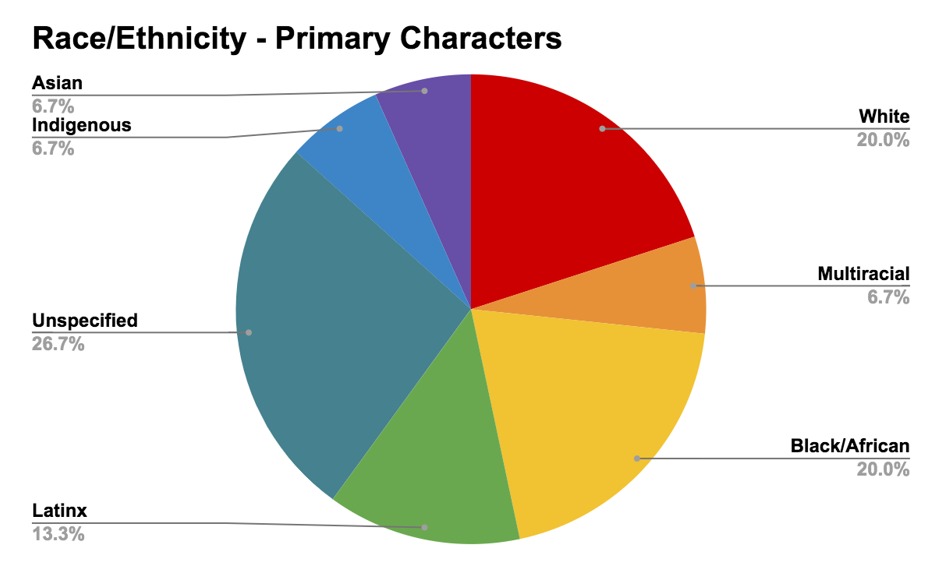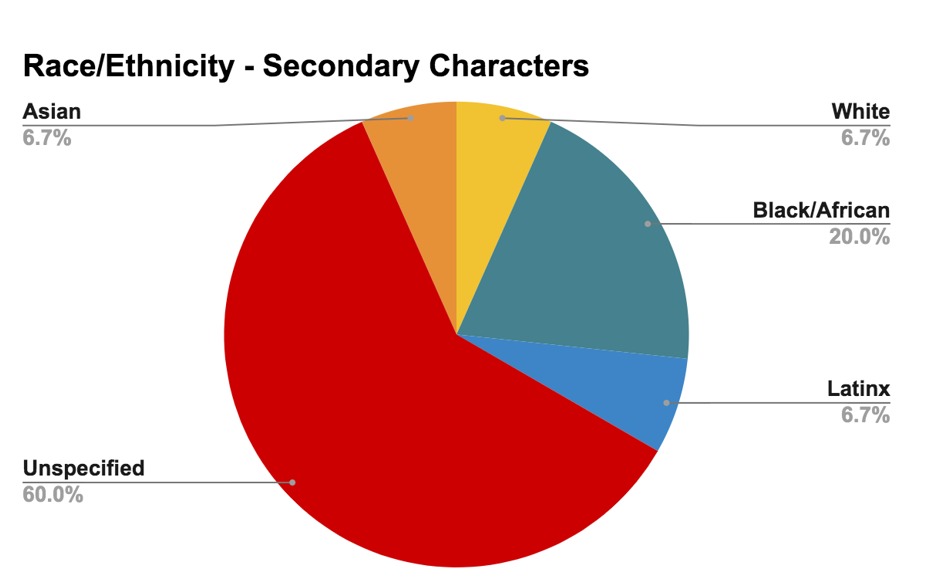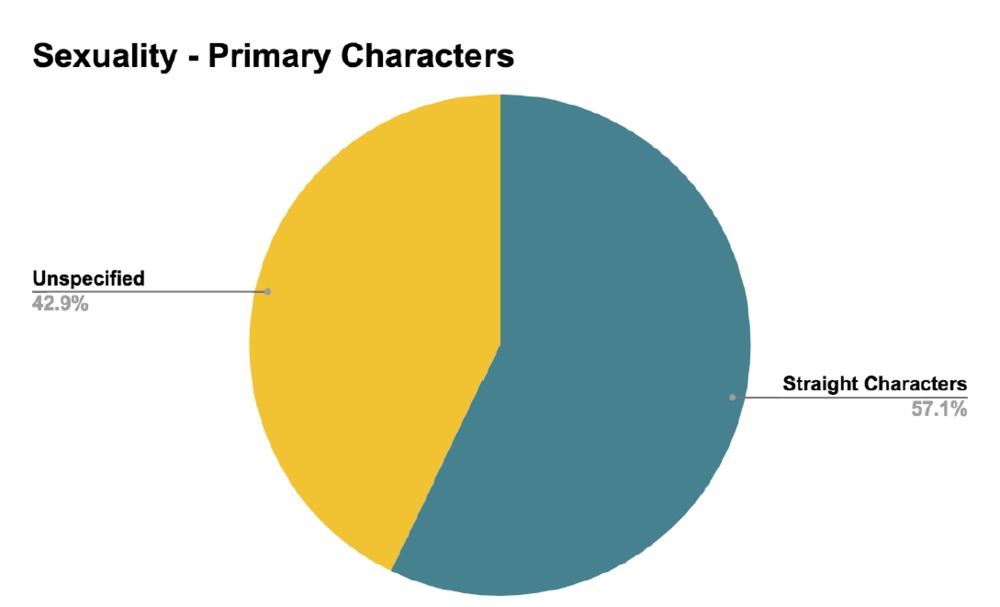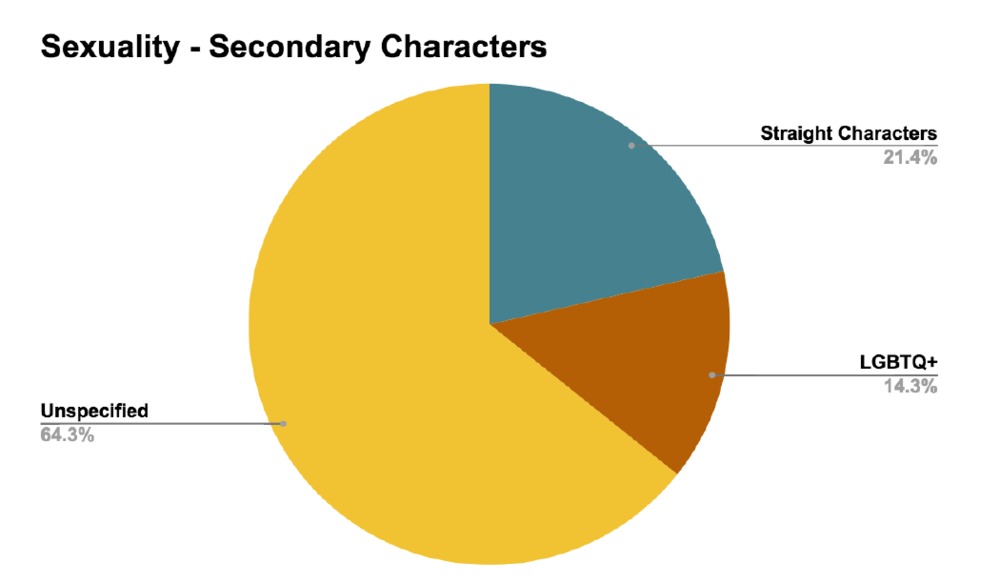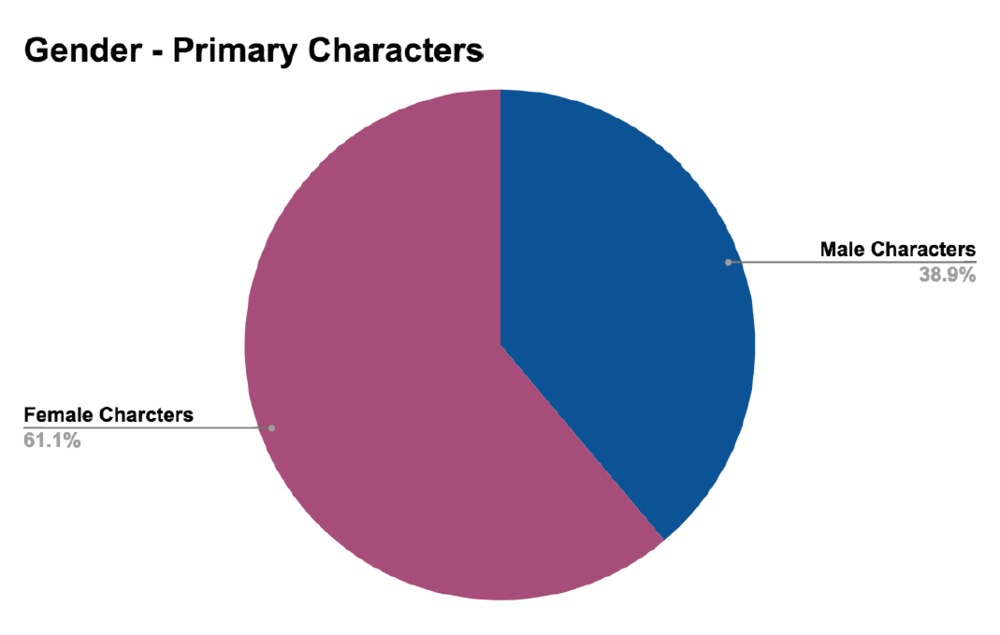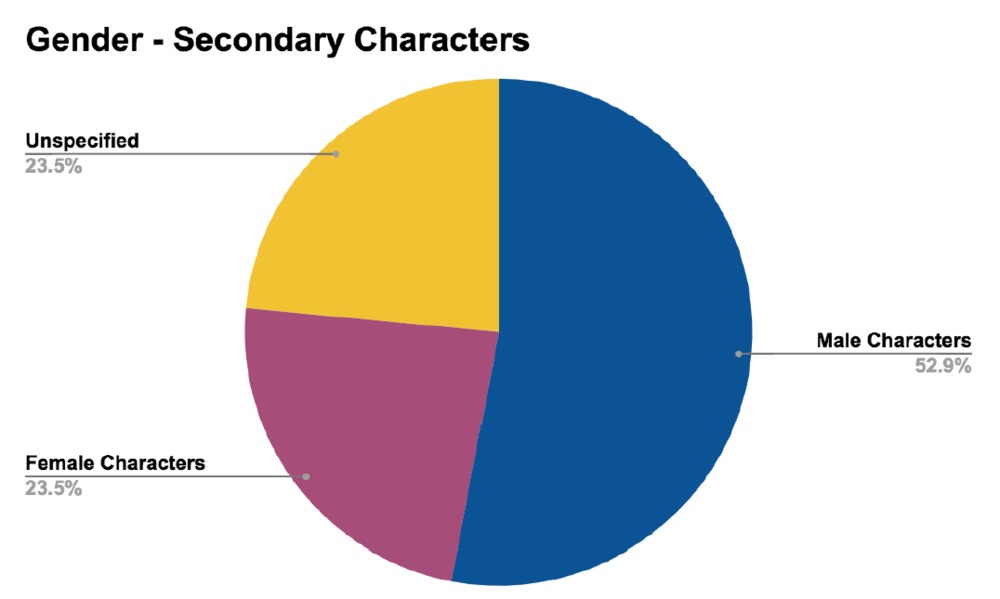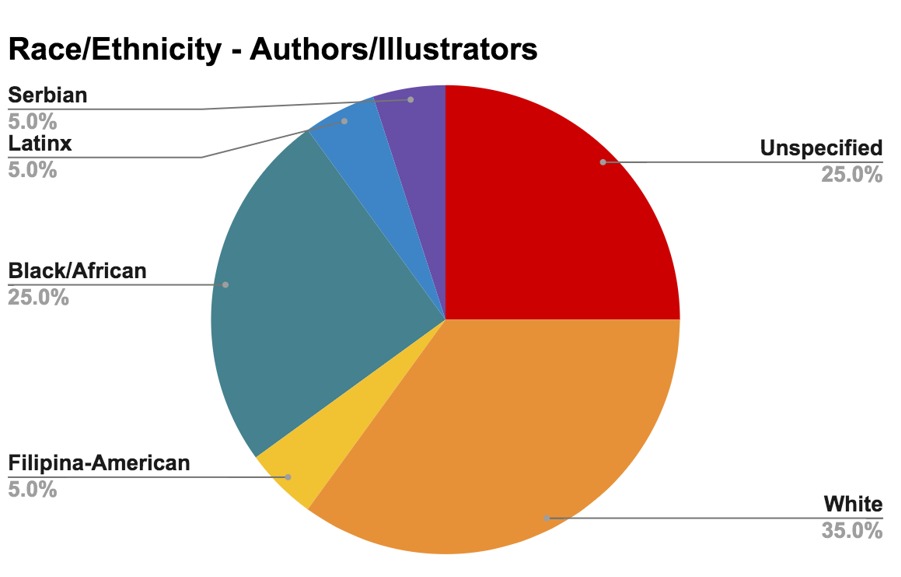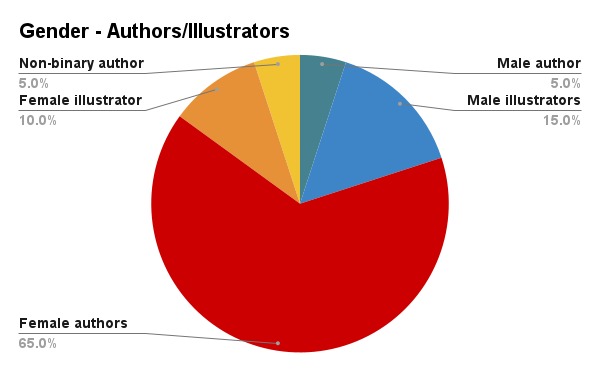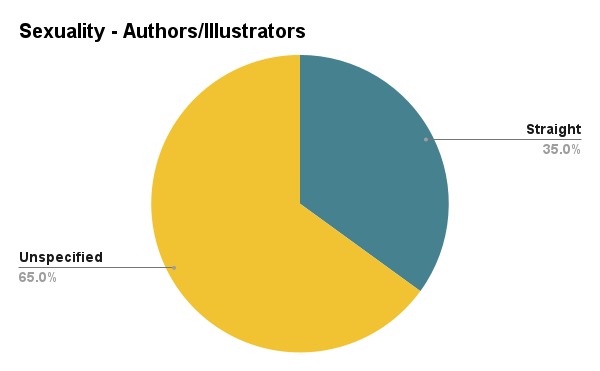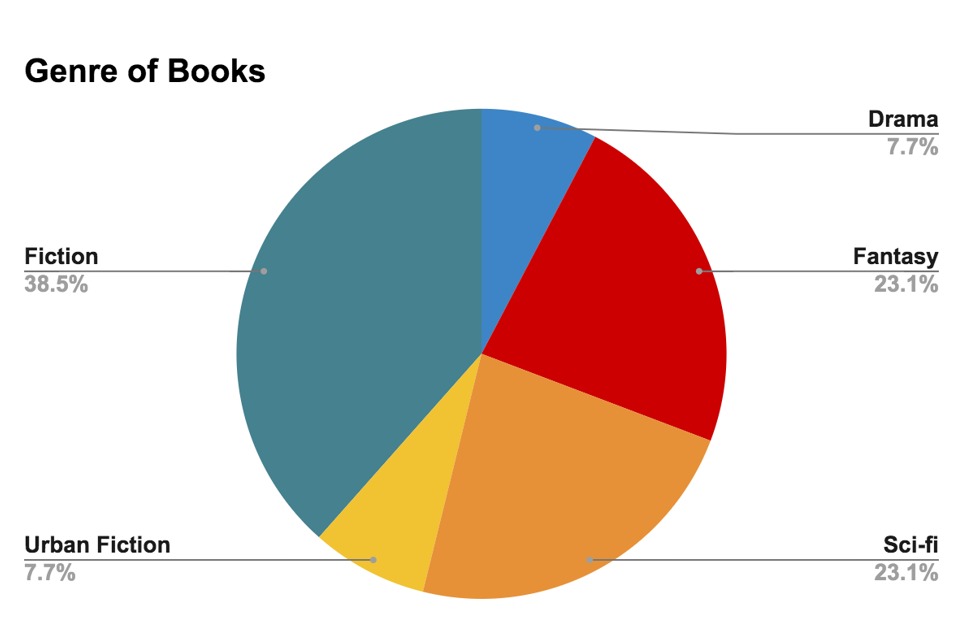What We Found
Our Process
After we catalogued all our items, we compiled lists of authors and characters to look at diversity within our books. We looked at the statistics in our display and made corresponding graphs to show how each category was divided.
Graphs and Analysis
Character Analysis
After analyzing our information, we can come to certain conclusions on diversity in YA literature. These first six graphs depict the race/ethnicity, sexuality and gender diversity within the characters of the thirteen YA books we have catalogued. We did not find any diversity in terms of disability for any of the novels. This is alarming as disbilities in every sense are important windows, mirrors, and sliding glass doors for young readers. This was one major issue we found, and something that should be addressed and changed.
From these results, it is clear that diversity in terms of race/ethnicity is prominent. Both the primary characters and the secondary characters are racially diverse. Our novels were chosen from an Indigenous owned bookstore which is devoted to promoting diversity within its texts, so the heightened representation of diversity was somewhat expected. However, because the display that we chose our books from was quite small, this was a surprising conclusion. We think this accurately represents YA literature, specifically in Ottawa, due to the nature of the independent bookstore. Even with the smaller display size, and the bookstore itself being small, there are ample depictions of racially diverse characters.
Another conclusion based on these graphs refers to the sexuality of these characters. Unlike the racial diversity we found from our selection of books, there are much less diverse representations of sexuality. Out of our thirteen books, there are only 2 (14.3%) secondary characters who are openly referred to as being part of the LGBTQIA+ community. The other characters in the text are either confirmed straight, or their sexuality is unspecified. There were some romance novels within our selection leading readers to believe that a typical YA romance novel consists of a straight couple. Therefore despite these novels including diverse representations of race and ethnicity, it is clear from these results that there is nowhere near enough representation of sexuality.
Lastly, we looked at different representations of the gender of these characters. From our graphs we can conclude that female characters are most common gender. The majority of our novels include female primary characters, which is an exciting change to see within YA literature. Feminist themes are more openly depicted, providing more representations of strong female characters, and thus more representations of windows and mirrors for readers. In our secondary characters graph, there are 4 (23.5%) characters whose genders are unspecified. This is another extremely important stastic to explore as the inclusion of non-binary and other identities is neccessary for readers to be able to see themselves within the texts they read. Though the representation of female characters is an extremely exciting advance in YA literature, it is also clear from our graphs that we need to expand our representation of gender past the normal limiting female/male ideology.
Author/illustrator Analysis
In terms of our authors, illustrators and contributors, there are separate graphs to depict diversity within the publishing industry of YA literature. We have three graphs that explore race/ethnicity, gender, and sexuality. Again, we found no diversity in terms of disability for any of our authors, leading to the conclusion that there is room for change. Our sample size was 20.
In the first graph, the representation of race and ethnicity within YA authors and illustrators is outlined. Similarly to our graph on the representation of race and ethnicity in the characters, there is large representation of BIPOC authors. Again, we can assume part of the reason we found this much representation is because of the nature of the bookstore where we selected our novels. As well, although there are many representations of a variety of races and ethnicities, the largest representation remains to be white authors and illustrators. This tells us that although there are representations of BIPOC authors, the norm within the publishing industry remains to be dominated by white authors and illustrators.
As well as a diverse representation of race and ethnicity within the YA publishing industry, our graphs conclude that female authors and illustrators are dominating YA literature. This is an importanyt shift in literature as male authors and illustrators had previously been dominating the industry. We are seeing representation of strong women as characters within our novels, but also as the people running the publishing industry. The female representation in the novels as well as in the publishing industry provides an important window and mirror for young readers.
An interesting example that emphasizes the change within YA literature and the prominence of female authors can be seen from the novel The Outsiders by S. E. Hinton. Hinton is a female author who published this novel in the mid-late twentieth century, when men dominated the industry. In order to be successful, the author abbreviated her name so the public and her readers would not suspect her gender. Female authors have come an extremely long way from when The Outsiders was published, and it is clear that females have progressed within the YA literature publishing industry.
The last conclusion illustrated by these graphs is in regards to the authors’ and illustrators’ sexualities. From this graph we can conclude that there were no openly queer authors or illustrators. Although many people’s sexualities were unspecified, there is no LGBTQIA+ representation in our selection of YA novels. This leads us to believe that significant efforts are still neccessary in order to change the heteronormative domination within the YA publishing industry.
The last thing we found was that many of our books were diverse in terms of genre. This leads us to believe that the genre pool for YA novels is slowly expanding and appealing to more audiences. We expected to have a majority of romance books, and though we had some, or some novels with romance in them, we had a wide range of genres.
Conclusions
Overall, we found that there is still rooom for more representation in YA fiction. Though the genre is becoming more diverse, and we were surprised with some of our results, there are changes that need to be made. The exclusion of disability, low numbers of LGBTQIA+ characters, and limiting genders of characters is alarming. We need to provide these books for young readers so they are able to see themselves within them, and find something to identify with.

